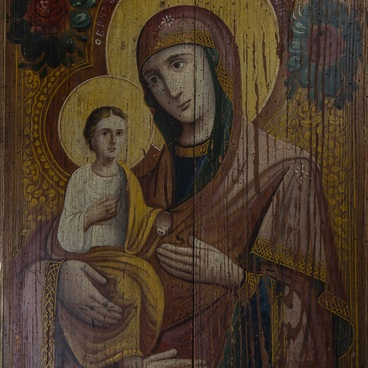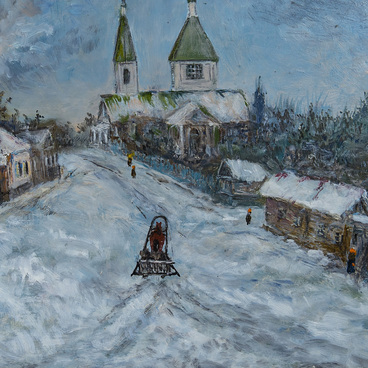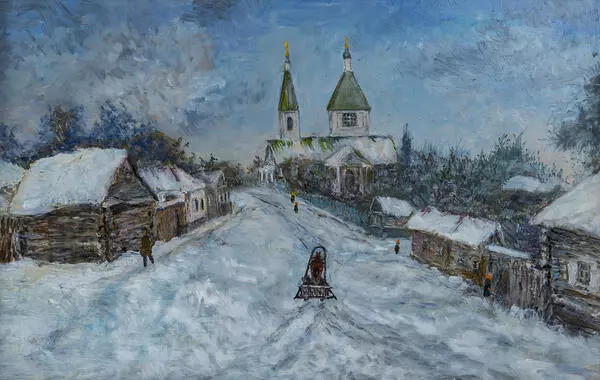Feodosy Rudoy came from an old Pogar bourgeois family. He was born on February 5, 1903. He studied at the Pogar four-years town high school and from 1918 — in a unified labor school. That was the name given to the new educational institutions after the 1918 education reform. According to it, boys and girls studied together, theology and old languages were no longer taught, and social and political disciplines were added to the usual curriculum.
After school, Rudoy graduated from the teacher training courses at the workers’ faculty (an educational establishment set up to prepare peasants and workers for higher education) of the Smolensk Institute. Then he taught at an elementary school in the village of Rogovichi, Pogarsky District. In 1930, he became the head of the Pogar school and seven years later — the head of the Local Education Authority.
In the mid-1980s, Rudoy created a set of paintings called “Old Pogar”. In his works the artist showed old streets, architectural monuments, and the nature of the village. Among the paintings of this set, there are not only original works, but also copies such as the canvas “Old Market in Pogar”.
Athanasy Zheltonozhsky, a doctor from Pogar, drew the painting from nature. In the 1970s, Feodosy Rudoy created a copy, which, according to art critics, turned out to be more professional and expressive. This Rudoy’s painting participated in competitions and exhibitions of folk art.
Rudoy worked with oil paints on a thin wooden board called fiberboard. The painting depicts the old Pogar market. It was located at the same place where the Pogar Park of Culture and Recreation is nowadays.
The painting is set in the 1920s. The center shows shops with covered sheds. In the background, there is the dome and bell tower of the Assumption Cathedral. There is a queue at the shops: people are waiting for the opening of a new store.
The Pogar markets and fairs have been the largest in the Bryansk region since the 17th century. Historian Sergey Solovyov mentioned 1664 as a more precise date of the first mentioning of the Pogar fairs. They were held three times a year and could last for several weeks. The weekly biddings were called “krasnye” (red). People from different cities, including Koenigsberg and Riga, came there with their goods.
After school, Rudoy graduated from the teacher training courses at the workers’ faculty (an educational establishment set up to prepare peasants and workers for higher education) of the Smolensk Institute. Then he taught at an elementary school in the village of Rogovichi, Pogarsky District. In 1930, he became the head of the Pogar school and seven years later — the head of the Local Education Authority.
In the mid-1980s, Rudoy created a set of paintings called “Old Pogar”. In his works the artist showed old streets, architectural monuments, and the nature of the village. Among the paintings of this set, there are not only original works, but also copies such as the canvas “Old Market in Pogar”.
Athanasy Zheltonozhsky, a doctor from Pogar, drew the painting from nature. In the 1970s, Feodosy Rudoy created a copy, which, according to art critics, turned out to be more professional and expressive. This Rudoy’s painting participated in competitions and exhibitions of folk art.
Rudoy worked with oil paints on a thin wooden board called fiberboard. The painting depicts the old Pogar market. It was located at the same place where the Pogar Park of Culture and Recreation is nowadays.
The painting is set in the 1920s. The center shows shops with covered sheds. In the background, there is the dome and bell tower of the Assumption Cathedral. There is a queue at the shops: people are waiting for the opening of a new store.
The Pogar markets and fairs have been the largest in the Bryansk region since the 17th century. Historian Sergey Solovyov mentioned 1664 as a more precise date of the first mentioning of the Pogar fairs. They were held three times a year and could last for several weeks. The weekly biddings were called “krasnye” (red). People from different cities, including Koenigsberg and Riga, came there with their goods.




